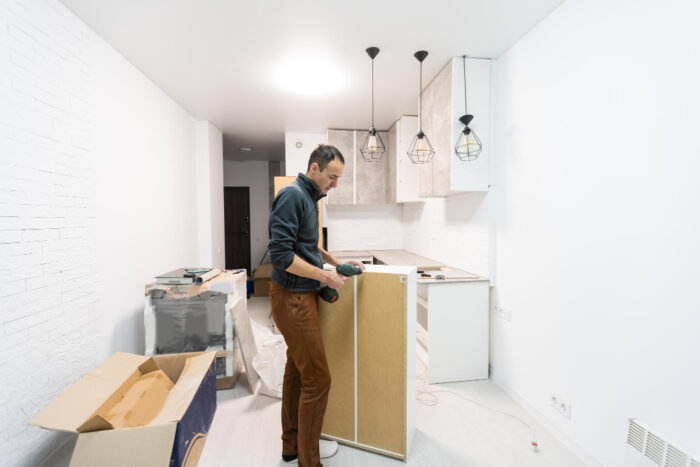
Renovating your home can be a rewarding yet daunting task, especially when operating on a budget. In an era where cost-effectiveness is key, do-it-yourself (DIY) hacks have emerged as a popular solution to transform your living space without breaking the bank. This guide aims to navigate the intricate process of budget-friendly home renovations, emphasizing the significance of DIY strategies for a cost-effective and personalized home improvement journey.
Assessing Your Renovation Needs
The first step in any renovation journey is to clearly identify what you hope to achieve. Whether it’s updating the look of your living room or making your bathroom more functional, understanding your renovation goals is crucial. Begin by inspecting each area of your home and noting what changes would make the biggest impact. Prioritize these changes based on your lifestyle needs and the potential to add value to your home. For instance, kitchen and bathroom renovations often yield the highest return on investment.

Setting a Realistic Budget
Creating a budget that reflects your financial situation is fundamental in avoiding overexpenditure. Start by determining how much you can afford to spend, then break down the costs associated with different aspects of your renovation project. Remember to set aside a contingency fund, typically 10-20% of your total budget, to cover unexpected expenses. To keep costs down, consider which aspects of your renovation can be done DIY and which might require professional services.
DIY vs. Hiring Professionals
While DIY projects can save money, they require time, skill, and patience. On the other hand, hiring professionals such as Smartcret offers expertise and efficiency, albeit at a higher cost. Assess your own skills and the complexity of the project before deciding. For tasks that require specialized knowledge, such as electrical or plumbing work, it’s often safer and more cost-effective in the long run to hire certified professionals. For cosmetic updates like painting or simple carpentry, a DIY approach can be both rewarding and budget-friendly.
Essential Tools and Materials
Having the right tools and materials is essential for a successful DIY renovation. Basic tools might include a hammer, screwdrivers, a drill, a saw, measuring tape, and safety gear. For materials, make a list based on your project plan, and don’t forget to include consumables like nails, screws, and sandpaper. To save money, consider buying second-hand tools or renting equipment for one-time use. Also, look for sales or discounted materials at local hardware stores or online marketplaces.

Planning Your DIY Renovation
A well-thought-out plan is the backbone of any successful renovation. Start by creating a detailed project timeline, setting realistic goals for each phase of the renovation. Consider factors like delivery times for materials and the availability of help if you’re enlisting friends or family. Break the project into manageable steps, and tackle one area at a time to avoid overwhelming yourself. Remember to plan for cleanup and disposal of renovation debris, ensuring your project is not only efficient but also environmentally responsible.
Flooring and Wall Makeovers
Revamping your home’s flooring and walls can dramatically change the ambiance without draining your wallet. For flooring, consider peel-and-stick vinyl tiles for an easy, budget-friendly facelift. These tiles come in a variety of patterns and are remarkably resilient. For hardwood floors that are looking dull, sanding and re-staining can bring back the original shine without the cost of replacement.
When it comes to walls, a fresh coat of paint can work wonders. Opt for light, neutral colors to make spaces appear larger and more inviting. Alternatively, add a pop of personality with an accent wall, either by painting it a bold color or using patterned wallpaper. For a textured look, try techniques like sponge painting or stenciling. Remember, when working with paints or adhesives, ensure proper ventilation and safety gear.
Kitchen and Bathroom Updates
Kitchen and bathroom renovations don’t have to mean a complete overhaul. Small, cost-effective changes can significantly impact. Painting cabinets can instantly brighten and modernize these spaces. Choose a durable, washable paint and consider updating the hardware for a complete transformation.
Updating fixtures like faucets, showerheads, or lighting can also modernize the space without a hefty price tag. Opt for water-efficient fixtures in the bathroom to save on utility bills. Peel-and-stick backsplash tiles are another budget-friendly way to add a fresh look to your kitchen or bathroom without the cost and mess of traditional tiling.

Maximizing Storage and Organization
A clutter-free home feels more spacious and inviting. Start by decluttering and then consider DIY storage solutions. Floating shelves add storage and display space without consuming floor area, making them ideal for small rooms. Consider converting an unused closet into a built-in office or craft area, adding shelving and a workspace.
Repurposing furniture is another great way to add storage. An old dresser can be transformed into a kitchen island with added storage, or an antique armoire can be a statement piece in the living room while hiding electronics or blankets.
Energy Efficiency Upgrades
Energy-efficient renovations not only save money in the long run but also contribute to a healthier planet. Start by sealing drafts around windows and doors with weather stripping or caulk. This small investment can significantly impact your energy bills.
Replacing old light bulbs with LED or CFL options will also cut energy costs. Consider adding a programmable thermostat to better control heating and cooling expenses. For larger projects, adding insulation to attics or walls can drastically improve your home’s energy efficiency.
Curb Appeal and Outdoor Renovations
First impressions matter, and enhancing your home’s curb appeal can significantly increase its value. Start with basic maintenance: mow the lawn, trim hedges, and remove weeds. Adding a fresh coat of paint to your front door, or replacing it altogether, can dramatically change your home’s appearance.
Consider installing outdoor lighting to highlight landscaping or architectural features. Solar-powered lights are a cost-effective and eco-friendly option. For a touch of color, add flower beds or potted plants. If you have a porch or patio, make it inviting with comfortable seating and decorative elements.

Safety and Permits
Safety should always be the top priority in any renovation project. Use appropriate safety gear, like gloves, goggles, and masks, especially when working with hazardous materials or tools. Understand your limitations and consult professionals when needed, especially for electrical or plumbing work.
For larger projects, ensure you understand the local regulations and obtain the necessary permits. This not only ensures safety but also avoids legal issues that could arise if the work does not comply with local building codes.
Conclusion
DIY home renovations are a cost-effective way to breathe new life into your space. From small updates like painting and adding storage to more significant energy-efficient upgrades, there are options for every budget and skill level. Remember to prioritize safety and legality, especially in larger projects. With these tips, you’re ready to transform your home into a more beautiful, functional, and efficient space. Embark on your DIY journey and enjoy the satisfaction of creating a home that truly reflects your style and needs.











